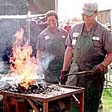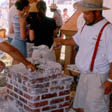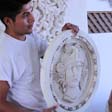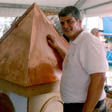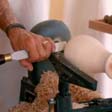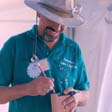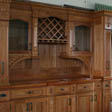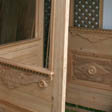More Than Just a Trade: Master Craftsmen of the Building Arts
It was really interesting work, and it's more than just a trade; I think it's an art. I worked for some very, very artistic people in the masonry field—old guys who really were craftsmen, and they loved their work. They lived their work; they lived masonry. It was interesting learning under these people.
- Pete Tucker
Table of Contents
Introduction: The New Orleans Building Arts Project
Builder's Voices
Brick Masonry
Carpentry
Ironworking and Blacksmithing
Tile Masonry and Painting
Plastering
Shoring, Plant & Maintenance Engineering
Wood Crafting
How the Seventh Ward Was Built
Labor Day

Introduction: The New Orleans Building Arts Project
By Laura Westbrook
One of the exciting aspects of the Louisiana Regional Folklife Program is that it facilitates looking at art in new ways. It is good to study contemporary, even fleeting, trends in art, and time will tell which artists or pieces will be seen as influential and culturally important. Traditional arts are distinguished by the fact that time has already determined them to be important and culturally relevant, not only for their influence on generations of artists, but because the practice of maintaining the art form continues to be meaningful to the cultures that call Louisiana home. Some art forms, such as brick masonry, are newly appreciated when they are put into an interpretive context; seen in a museum, a complex brick wall seems new and beautiful, though we pass by similar ones each day without a glance. The Regional Folklife Program further ensures that public interpretation of traditional arts will be as accurate as possible by working in partnership with artists and by encouraging and assisting residents to conduct documentation projects and to develop public presentations of area traditions and culture. In this way, documentation and presentation projects have the most effective "afterlife" possible, through various arts, education and training, and economic development projects.
The traditional art forms that are documented and assisted by the Regional Folklife Program are far from the defunct, "folksy" crafts sometimes presented by vending artisans or living history attractions that present traditions that are no longer generally practiced, but are dynamic, living cultural traditions maintained by the communities from which they evolved. Many of these—such as the Italian traditions of artistry with marble and plaster, or the innovative facility with which New Orleans' African-American and Creole artists utilize beadwork and feathers—go right to the heart of cultural identity, family and community alliances, and self-expression within a cultural group.
The Greater New Orleans Regional Folklife Program at the University of New Orleans chose, as the focus for its first cultural survey, the traditional methods by which local artisans maintain our built environment. Widely-recognized master craftsmen helped us to develop a list of artisans who should be interviewed, and we were able to visit with most of them. Some of the men we interviewed have since passed away, and we feel lucky to have their voices in our archive. Students from the University of New Orleans and Tulane University, and some community members, were trained in interview methods, and they conducted the majority of the interviews. Their names are: Their names are: George Abry, Keri Coumanis, Heather Knight, Gerard Legaux, Frankie Legaux, Ray Poret, Lisa Richardson, Bethany Rogers, Daniel Sammuels, Aimee Schmidt. The Greater New Orleans Regional Folklife Program hosted by the University of New Orleans' College of Urban and Public Affairs conducted the New Orleans Building Arts Project with a grant from the National Endowment for the Arts administered by the New Orleans Museum of Art. The Regional Folklife Program is an outreach program of the Louisiana Division of the Arts Folklife Program.
A number of themes emerged from the interviews. Many of the men spoke with pride of their cultural heritage and the importance that close community relationships had in their lives. They mentioned particular jobs of which they were especially proud. They directed our attention to connections between building arts and other arts—especially music. They praised those teachers who trained them, whether they were family members, community mentors, union trainers, or school teachers. Most of the men learned from both family connections and other mentors. They talked about changes in the unions, changes in their communities, and changes in the trades. They spoke of their concerns and hopes for the future of their trades. Most of all, they spoke of rich, eventful lives spent honing the crafts they love.
The interviews were used as the basis for an exhibition at the New Orleans Museum of Art (NOMA), which was called "Raised to the Trade: Creole Building Arts of New Orleans." In this context, the word "creole" was used to indicate that many cultures, and the crafts of many cultures, had come together to create something new—the distinctive architecture of the city of New Orleans. The New Orleans Building Arts Project was also the basis for my digital presentation,"With These Hands: Stories of New Orleans' Master Craftsmen" that features the voices of the craftsmen who took part in our survey, describing the things that are important to them, without being "interpreted" by scholars or presenters. The survey also resulted in a family-oriented hands-on festival held in New Orleans' City Park, a moderated panel session held at NOMA, at least one masters' thesis, and demonstrations at the Smithsonian Festival of American Folklife and at the New Orleans Jazz and Heritage Festival. Most importantly, the project inspired, or helped to revive, efforts to develop building arts education programs.
I have selected a small but representative sample from each interview, and hope that the craftsmen, who gave generously of their time for this survey, will feel that these brief samples do them justice. Unique speech patterns have, for the most part, been left intact so the reader can get a feel for the craftsmen's personalities. It was a difficult task because it was almost impossible to choose brief passages and leave the rest out, but readers can find the complete interview transcripts at the Earl K. Long Library, Louisiana and Special Collections Department, on the University of New Orleans campus. I am delighted to share these pages and have no doubt that you will find them informative and delightful. These men are not only master craftsmen; they are also master storytellers.


